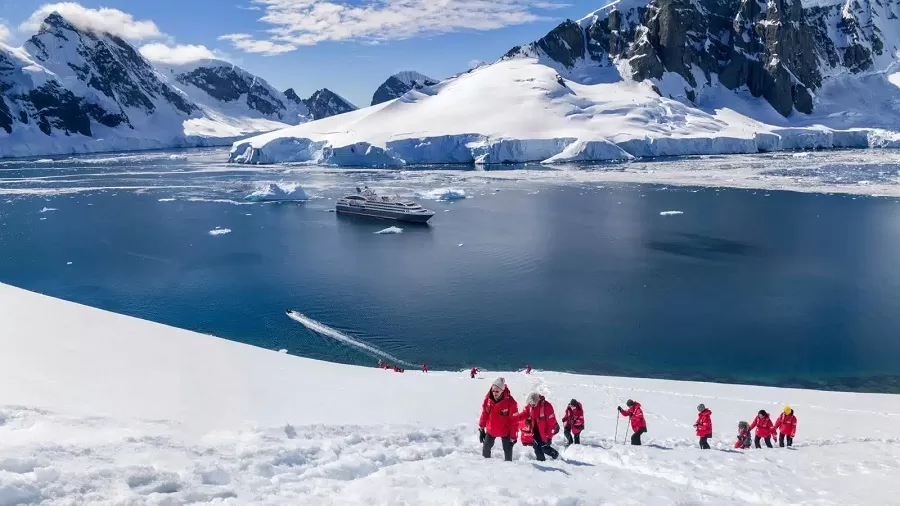Travel
Polar Tourism Boom: Protecting Fragile Ecosystems While Exploring

- Experts have issued warnings on the development of liminal tourism, causing damage to fragile ecosystems and urging tourists to adopt more sustainable practices.
- Travelling in an eco-friendly way can only slightly reduce harmful effects, while using trains, supporting local economies, and respecting wildlife may help limit the influence on the environment.
The icy landscapes of the Arctic and Antarctic have a pull much like that of some mysterious wonder—be it the colourful coastal villages in Greenland, the broad swath of unspoiled, frozen terrain of Antarctica, or the thrill of a whale’s blow in the icy waters. However, with tourism going up a notch in these far-flung corners, experts are nervous about the obvious repercussions—or grave impact that could follow—vacations, and everything else in between. With cruise ships and planes to the food consumed and the etiquette in place around wildlife, there are numerous methods of being more responsible during your polar adventure, rather than missing out on the trip of a lifetime.
Polar Tourism Is Booming
Just think about the growth in the number of tourists who visited Greenland to the extent that between 2018 and 2023, they had nearly a 46% increase, which saw 131,767 arrivals last year in Greenland alone. It is projected that this track record of increasing visitor numbers may continue to express henceforth because the number is growing year by year. The expansion of the Nuuk airport and the construction of two additional international airports are both expected to operate by 2026.
At the other end of the world, Antarctica is being visited by more and more tourists. Throughout the 2022-23 season, just under 105,000 trekked to the south while, by 2024, the figure had skyrocketed to 124,262, with over 80,000 tourists setting foot on Antarctica for the first time. Since the huge influx of visitors is a big boon to local economies and scientific campaigns, conservationists have warned that the subtle ecosystems of the Poles are endangered. Through the unintended introduction of alien species that compete with and threaten Indigenous fauna and flora, human presence can rattle wildlife behaviour and natural peace.
Choosing Green Transport
The method of transport that you decide to take on your trip will go a long way in determining your positive attitude towards the polar regions. At first sight, it may seem noble to sail instead of fly, but the carbon footprint of boats is slightly worse than that of aeroplanes. Shipping alone accounts for 3% of global carbon emissions as opposed to the 2.5% generated by the aviation industry. Also, the hum of ship engines would interfere with the echolocation of whales in the wild.
Marine ecologist James Grecian of Durham University has studied polar wildlife for years. He suggests considering the train when it is possible to do so. Although the train will take longer, it can decrease CO2 emissions by up to 95% as compared to actually flying. Thus, you can, for example, catch trains directly to Narvik in Arctic Norway from Sweden, or Helsinki to Rovaniemi in Finland.
A more wild and eco-friendly approach – if one were half of a million dollars willing – would be chartering a small sailing boat. Adventurous travellers routinely sail from the Falkland Islands to Antarctica, with costs that can be comparable to those of luxury cruise fares. It’s not for everyone, but it is a thought-provoking, one-of-a-kind, and practically zero-impact way of enjoying these pristine places.
Respect for Wildlife – No Selfie Is Worth the Stress
Witnessing polar animal life face-to-face is probably the highlight of a traveller’s stuff; a lot of responsibility comes along with it, perhaps. “One damaging but increasingly present threat is the chase for selfies with animals,” emphasised Grecian. Polar critters, especially seals, penguins, whales, and polar bears have little experience with humans. So, a so-called “close encounter” may bring discomfort or affect the animal’s behaviour.
The key is to exercise patience. “If you stay still, some might be curious about you and come over,” Grecian said. In the case of his Falklands visit, penguins were presented within two or three metres of him, simply from his staying still and showing them respect. Sometimes, little things like these greatly reinforce the experience. “Look down occasionally,” he advised. “You might spot footprints, scat, or other signs of animal activity.”
Eat Local to Reduce Your Impact
Eating local can be one of the best green choices a person in the High Arctic could make. The carbon cost of transporting food to such remote regions only adds to their environmental burden.
Traditional wildlife hunting and gathering, or “subsistence lifestyle,” is still practised by the Inuit and Kalaallit in Greenland and parts of Arctic Canada, as protected by law. On the whole, eating seal meat, for example, is a more sustainable option compared to imported meat, which has a high carbon footprint. A recent study of surveys in Greenland has shown that locally sourced seal meat has a significantly lower environmental impact compared to imported pork or poultry.
Please remember that all in all, seal meat is not for all. Visiting Inuit communities, though, and trying local fare can increase support for traditions and can help reduce your carbon footprint by limiting food miles.

Packing Smart: Go Easy on the Environment, Save Freight, and Help Out Local Business
When bundled off to a polar trip, do so with commodities in minimum quantity – some pros even emphasise the prospect of supporting local businesses, renting gear right here instead of hauling everything from home. In mysterious ways, this aids that community’s economy and also lightens your load to some extent while reducing the carbon footprint associated with hauling around hardy soft-sided bags.
While nasal sprays are an everyday item for busy moms or caring dads, they may help prevent nosebleeds whenever the polar air presses down dry and suddenly volatile. When out there, a high-factor sunscreen can come in very useful – in all likelihood, polar rays are heavier than they initially appear. Carry something you can cook porridge in, along with an extra tin or two of tuna to perk up your beans. “In my last expedition, I brought along a moka pot and a French press for coffee,” Grecian adds. “Sometimes in cold temperatures, nothing can beat a good cup of coffee.”
Travel at the Right Times: Follow Nature’s Calendar
The visibility of polar wildlife or major natural events depends very much on when you travel. I didn’t see a single whale while in Greenland; it dawned on me that I’d reached the place just when they were about to migrate to the Caribbean.
Kim-Grecian suggests that the traveller researches the migration or seasonal timetable while booking transportation. For instance, the travel of icebergs from the northeast coast of Newfoundland is at its prime during May and June when they float south. Different times of the year are superior to others for penguins and northern lights. When you plan your trip around nature, everyone gets a better experience, and the pressure on the environment is eased during the high tourist season.
Useful Concepts on Responsible Travel and the Concept of No Trace
Travelling responsibly toward the polar regions means adding to and enhancing the experience, rather than withdrawing from it. Selecting transportation options that impact poorly on the environment; working with local peoples; and courtesy towards wildlife species are major considerations in the kind of experience one can sign up for.
There exists a need to apply real wisdom whilst contemplating a range of issues or options surrounding one’s choices; Antony promised that by behaving in ways that leave little trace behind, one is somewhat actively protecting the capability or resource of these awe-inspiring landscapes for the remote release of oncoming wanderers. For if the beauty certainly lies in the frailty of the polar regions, all earthly beings should try and maintain their proper status.

















































